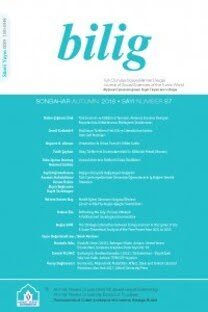Köktürkçenin Sıfat Fiilli Yapı Tipolojisi
The Typology of Relative Clause Constructions in Orkhon Turkic
___
Alyılmaz, Cengiz (1994). Orhun Yazıtlarının Söz Dizimi. Erzurum: Atatürk Üniversitesi Yay.Ardalı, R. (1981). “Çağdaş Dilbilim Açısından Ortaçlar”. Selçuk Üniversitesi Fen-Edebiyat Fak. Dergisi 1. Konya.
Bayraktar, Nesrin (2004). Türkçede Fiilimsiler. Ankara: TDK yay.
Chomsky, Noam (1957). Syntactic Structure. London: The Hague. Paris: Mouton & Co.
Chomsky, Noam(1965). Aspects of the Theory of Syntax. Massachusetts: M.I.T press.
Chomsky, Noam (1981). Lectures on Government and Binding. Dordrecht: Foris.
Chomsky, Noam (1986). Knowledge of Language: Its Nature. Origin and Use. New York: Praeger Publisher.
Chomsky, Noam(1995). The Minimalist Program. Cambridge: MIT Press.
Croft, William (1993). Typology and Universal. Cambridge: University of Cambridge Press.
Crystal, David (1992). A Dictionary of Linguistics and Phonetics. Massachusetts: Blackwell Publish.
Csató, Éva (1985). “A syntactic Analysis of Participle Constructions in Modern Turkish”, Beşinci Milletlerarası Türkoloji Kongresi. Istanbul: Istanbul Edebiyat Fakültesi Yayınları. 39-56.
Csató, Éva(1996). “A Typological Review of relative clause Constructions in Some Turkic Languages”. Proceedings of 5th International Conference on Turkish Linguistics. August 15-17 (1990) (ed.). Bengisu Rona. Ankara: Hi-tit Yayınevi. 28-32.
Dede, Müşerref (1978). “Why Should Turkish Relativization Distinguish Between Subject and Non-Subject Head Nouns? Proceedings of the 4th Annual Meeting of the Berkeley Linguistics Society 4. 67-77.
Eraslan, Kemal (1980). Eski Türkçede İsim-Filler. İstanbul: İÜEF yay.
Erkman-Akerson, Fatma ve Şeyda Özil (1998). Türkçede Niteleme Sıfat İşlevli Yan Tümceler. İstanbul: Simurg Yayınları.
Ergin, Muharrem (1972). Türk Dilbilgisi. İstanbul: Boğaziçi yay.
Ergin, Muharrem (1988). Orhun Abideleri. İstanbul: Boğaziçi yay.
Gabain, A.M. (1974). Altturkische Grammatik. Wiesbaden: Otto Harrassowitz. Çev. Mehmet Akalın 1988. Eski Türkçenin Grameri. Ankara: TDK.
Gencan, Tahir Necat (1979). Dilbilgisi. Ankara: TDK.
Göktağ, Bilgehan Atsız (1993). Oğuz Grubu Türk Şivelerinde Sıfat-Fiiller, yayınlanmamış Doktora Tezi. Erciyes Üniversitesi .
Haegeman, Liliane (1995). Introduction to Government and Binding Theory, 2nd Ed., Oxford & Cambridge: Blackwell Publish.
Haig, Goeffry (1998). Relative Constructions in Turkish. Wiesbaden: Harrassowitz Verlag.
Hankhamer, J. (1973). “Unacceptable Ambiguity”. Linguitic Inquiry 4. 17-68.
Hovdhaugen, E. (1975). “Relative Clauses in Turkish”. Bilimsel Bildiriler. Ankara: TDK.
Karabulut, Ferhat (2003). Relative Clause Constructions in Kazakh. University of Wisconsin, unpublished Ph.D. Dissertation.
Knecht, Laura and Jorge Hankhamer (1979). “The Role of Subject/Non-Subject Distinction in Determining the Choice of relative clause Participle in Turkish”. in Harvard Studies in Syntax and Semantics V. II, (ed) J. Aissen and J. Hankamer.
Lehmann, Christian (1984). Der Relativsatz. Language Universal series III. Tubingen: Narr
Lehmann, Christian (1986). “On the Typology of relative clauses”. Linguistics V. 24.
Maher, John and Judy Groves (2001). Introducing Chomsky. Cambridge: Icon Books & Totem Books.
Mosel, U. and E.Hovhaugen. (1992). Samoan Reference Grammar. Oslo: Scandinavisan Universiry Press.
Radford, Andrew (1986). Trnasformational Syntax. London. New York & Sydney: Cambridge University Press.
Radford, Andrew (1992). Transformational Grammar. Cambridge: University of Cambridge Press.
Schönig, Claus (1992/93). “Relativsatzbautypen in den Sogenannten Altaischen Sprachen”. Acta Orientalia Academiae Scientiarum Hung. Tomus XLVI (2-2).
Tekin, Talat (2000). Orhun Türkçesi Grameri. Sanat Kitabevi. Ankara.
Tekin, Talat(1988). Orhun Yazıtları. Ankara: TDK.
Trask, R.L. (1999). Key Concepts in Language and Linguistics. London & New York: Routledge.
Ulutaş, İsmail (2002), Relative Clause Constructions in Gagavuz. unpublished, University of Wisconsin, Ph.D. Dissertation.
Underhill, Robert (1972). “Turkish Participle”. Linguistic Inquiry. Vol. III. Çev. Ferhat Karabulut. “Türkçe Sıfat Fiiller” Celal Bayar Üniversitesi Sosyal Bilimler Enstitüsü Dergisi. Cilt 3. Sayı 2. 2005
Uzun, Nadir Engin (2000). Anaçizgileriyle Evrensel Dilbilgisi ve Türkçe. İstanbul: Multilingual.
Valin, Robert Van(2001). An Introduction to Syntax. Cambridge: Cambridege University Press.
Zimmer, Karl (1987). “Turkish Relativization Revisited”. Studies on Modern Turkish Proceeding of the Third Annual Conference on Turkish Linguistics. Hendrik Boeschoten & Luda Verhoeven. Tilburg: Tilburg University Press.
Zimmer, Karl (1996). “Overlapping Strategies in Turkish Relativization”. Current Issues in Turkish Linguistics. Fifth International Conference on Turkish Linguistics 1990, Ankara: Hitit Yayınevi.
- ISSN: 1301-0549
- Yayın Aralığı: 4
- Başlangıç: 1996
- Yayıncı: Ahmet Yesevi Üniversitesi Mütevelli Heyet Başkanlığı
Kırgızistan’da Üniversite Gençliği ve İnternet: Bir Kullanımlar ve Doyumlar Araştırması
Tarık Buğra’nın Öyküleri ve Öykücülüğü
İktisadî Adamdan Toplum Adamına
Altay Tuvaları - Altaylarda Unutulmuş Bir Türk Halkı
Divânü Lugâti’t-Türk’te Kençekler ve Bazı Kençekçe Kelimeler Üzerine Düşünceler
Kazak Kültürel Hayatında Tatarların Etkisi ve Kazak Ceditçiliğinin Gelişimi
Timurluların İslam Maden Sanatına Katkıları
Emperyalizmin Ortadoğu Tecrübesinden Bir Kesit: Suriye’de Fransız Mandası
Kazakistan Ekonomisinin Petrole Bağımlılığının Azaltılmasında Para Politikasının Rolü
